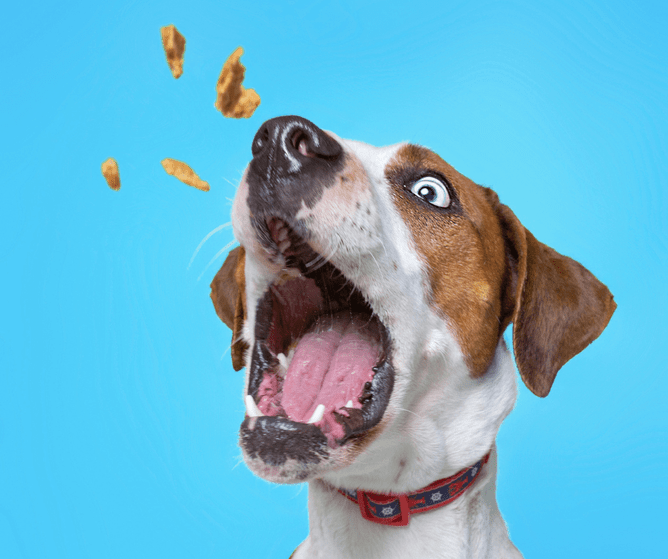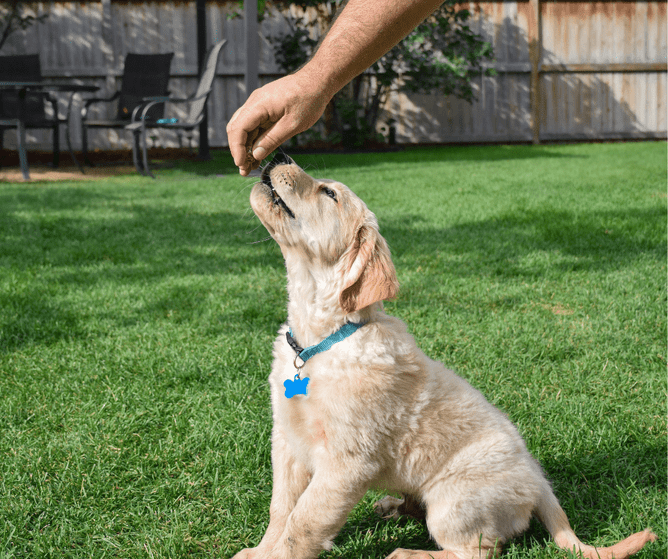Treats for Training
Why use treats?
We use treats in our training classes and privates as food is a primary reinforcer for dogs – they don’t need to learn to like food! Dogs have to eat – every day, so why not use this as training opportunities?
It doesn’t mean that you can’t use other reinforcers down the track – play, pats, attention etc. However, food is a very effective reinforcer when you start teaching new behaviours and your dog will learn faster.
The 5-10% Rule
Treats and snacks should only make up 5-10% of a dog’s daily calories. We also encourage you to feed your dog’s daily diet as part of their training.
An exception to the 5-10% rule may be if your dog is in the early stages of training, and you find you are using more than 10% in some circumstances (e.g. a training class). This can be fine for short periods and on training days. Just reduce the amount of dinner your dog gets!
Treat size
Treats for training should be the size of a pea (or half a pea for smaller dogs), or the end of a pencil. You can reward more often, and in higher and faster amounts if the treats are kept small.
Recommended Training Treats
Cooked plain meats (chicken, lamb, beef etc.). The best option is to cook chicken breast, or beef in healthy oil or a non-stick pan. Cool before cutting up and dividing into bags and freezing.
Ziwipeak - natural air dried food made from real meats and organs and a great size for training.
Prime 100 single protein roll or Prime Pantry - Great for dogs with allergies, and are grain and gluten free, this is a cooked (steamed), easy to handle and cut up roll that can be used as training treats. This is a complete and balanced food so it’s great for puppy training treats!
Prime 100 also comes in an air dried version.
Kiwi Kitchens have freeze dried treat varieties made from meat and organs.
Remember that small soft/meaty treats are easier for your dog to swallow
Baby Food Squeeze tube – These are great for puppy class and certain exercises such as recall training and husbandry procedures. Look for organic, no additives or preservatives, colours for flavours, no onion, soy, milk etc. Try the plain organic fruit varieties.
Dried meats (chicken, lamb, beef, pork, kangaroo, venison, duck) * Freeze or air dried.
Dried organs (freeze or air dried) (heart, liver, kidney, lung) *
Dried whitebait or anchovies (fish) *
*We recommend dried meats, fish and organs should be 100% Australian product, air dried (not chemically dried) with no additives or preservatives. Look for local suppliers such as Chew Chomp and Chill or dry your own in a dehydrator or oven.
Make your own treats
We like using silicon baking trays and various recipes to make small, tasty, healthy treats. Ask us for the recipes or check with your trainer.
Treats to Use in Moderation
Fruit – apple, pear, berries cut into small pieces.
Veges – carrots, peas, sweet potato (chopped into tiny pieces)
Fruit and vege can be great especially for the weight conscious pooch, however some dogs tolerate these differently, so use small servings and check with your vet.
Carob or Yoghurt drops - Carob is safe for dogs (unlike chocolate), but stick to small amounts as it can cause tummy upsets. Yoghurt drops for dogs are fine, but again, only in moderation.
Cheese - Only use cheese in very small amounts. Some dogs can be lactose intolerant.
Long lasting treats
A long lasting chew or treat is useful in class to help your dog settle. Chewing is also self-soothing and can help to release those feel good endorphins.
Make sure your chew is air or freeze dried, with no added chemicals or preservatives and is an Australian product.
Examples:
Chicken jerky
Kangaroo tendon
Kangaroo jerky
Kangaroo ear
Shark/fish skin
Shark cartilage
Shark tail
Lambs ear
Beef ear
Bully stick
Venison ear
Small, tasty, healthy and easy to eat treats!
This is what you are aiming for in classes. They should be easy and quick to handle and give your dog so you can reinforce at the right time/s and therefore strengthen behaviours.
Happy Training!


